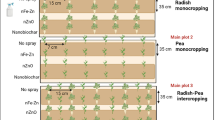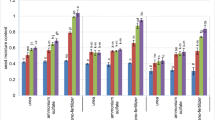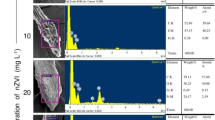Abstract
A large part of the world has nutrients-deficient soil, where chemical fertiliser application is cost prohibitive. Plants with superior root system architecture perform better in such soils by virtue of their superior mineral assimilation potential. Earlier we showed that seed pre-treatment with nano-pyrite (FeS2/Py) results in improved root architecture in chickpea, Sesamum, carrot and beetroot. Here we have developed a root-priming strategy for crops requiring transplantation. As a case study, roots of 28-days-old chilli and marigold seedlings were primed for 3 h in an aqueous suspension of nano-pyrite (@100 µg/ml), prior to transplantation, resulting in significant increase in the fruit and flower yield respectively. Chilli yields for control (without nitrogen, phosphorous, potash (NPK) or root priming), with NPK application only, with nano-pyrite root-priming only, and with nano-pyrite root-priming along with NPK application were found out to be 1327.60 ± 85.15, 1966.46 ± 11.15, 2118.23 ± 67.69, and 3322.43 ± 109.89 (mean (kg/ha) ± standard deviation, n = 3 replications) respectively. Mean marigold flower number per plant for control and nano-pyrite root priming were found to be ~ 13 and ~ 27, respectively (n = 30). We validate these results by proposing an ionic model explaining the observed root-priming effect. Temporal pH measurement during 3 h of root priming; elemental analysis of roots after 3 h priming and 30 days of transplantation after priming; and root system analysis after 30 days of transplantation were further conducted to firmly establish the role of nano-pyrite in redesigning the root architecture. This study is one of its kind in establishing, that application of a nano-material can modulate root architecture and thereby, influence the overall performance of the plant.















Similar content being viewed by others
References
Cheeseman JM (2007) Hydrogen peroxide and plant stress: a challenging relationship. Plant Stress 1:4–15
Choudhury B (1990) Vegetables. National book Trust, New Delhi
Das CK, Srivastava G, Dubey A et al (2016a) Nano-iron pyrite seed dressing: a sustainable intervention to reduce fertilizer consumption in vegetable (beetroot, carrot), spice (fenugreek), fodder (alfalfa), and oilseed (mustard, sesamum) crops. Nanotechnol Environ Eng 1:2
Das CK, Srivastava G, Dubey A et al (2016b) The seed stimulant effect of nano iron pyrite is compromised by nano cerium oxide: regulation by the trace ionic species generated in the aqueous suspension of iron pyrite. RSC Adv 6:67029–67038
Das CK, Jangir H, Kumar J et al (2018) Nano-pyrite seed dressing: a sustainable design for NPK equivalent rice production. Nanotechnol Environ Eng 3:14
Deepa M, Sudhakar P, Nagamadhuri KV et al (2015) First evidence on phloem transport of nanoscale calcium oxide in groundnut using solution culture technique. Appl Nanosci 5:545
Felle HH (2001) pH: Signal and messenger in plant cells. Plant biol 3:577–591
Gaxiola RA, Palmgren MG, Schumacher K (2007) Plant proton pumps. FEBS Lett 581:2204–2214
Gilbert N (2012) African agriculture: Dirt poor. Nature 483:525–527
Gil-Lozano C, Losa-Lisa-Adams E, Dávila AF, Gago-Duport L (2014) Pyrite nanoparticles as a Fenton-like reagent for in situ remediation of organic pollutants. Beilstein J Nanotechnol 5:855–864
Haynes RJ (1990) Active ion uptake and maintenance of cation-anion balance: a critical examination of their role in regulating rhizosphere pH. Plant Soil 126:247–264
Hinsinger P, Plassard C, Tang C, Jaillard B (2003) Origins of root mediated pH changes in the rhizosphere and their responses to environmental constraints: A review. Plant Soil 248:43–59
Jeyasubramanian K, Thoppey UUG, Hikku GS et al (2016) Enhancement in growth rate and productivity of spinach grown in hydroponics with iron oxide nanoparticles. RSC Adv 6:15451–15459
Joshi A, Kaur S, Singh P et al (2018) Tracking multi-walled carbon nanotubes inside oat (Avena sativa L.) plants and assessing their effect on growth, yield, and mammalian (human) cell viability. Appl Nanosci 8:1399
Li X, Yang Y, Gao B, Zhang M (2015) Stimulation of peanut seedling development and growth by zero-valent iron nanoparticles at low concentrations. PLoS One 10:e0122884
Li G, Kronzucker HJ, Shi W (2016) The response of the root apex in plant adaptation to iron heterogeneity in soil. Front Plant Sci 7:344
Lynch JP (1995) Root architecture and plant productivity. Plant Physiol 109:7–13
Lynch JP, Brown K (2012) New roots for agriculture-exploiting the root phenome. Philos Trans R Soc Lond B Biol Sci 367:1598–1604
Lynch JP, St Clair SB (2004) Mineral stress: the missing link in understanding how global climate change will affect plants in real world soils. Field Crops Res 90:101–115
Nye PH (1981) Changes of pH across the rhizosphere induced by roots. Plant Soil 100:127–134
Palchoudhury S, Jungjohann K L, Weerasena L et al (2018) Enhanced legume root growth with pre-soaking in α-Fe2O3 nanoparticle fertilizer. RSC Adv 8:24075–24083
Pequerul A, Pérez C, Madero P, Val J, Monge E (1993) A rapid wet digestion method for plant analysis. In: Fragoso MAC, Van Beusichem ML, Houwers A (eds) Optimization of plant nutrition. Developments in plant and soil sciences, vol 53. Springer, Dordrecht
Prianischnikow D (1929) Zur Frage nach der Ammoniakern ahrung von hoheren Pflanzen. Biochim Zeitschrift 227:341–349
Shankramma K, Yallappa S, Shivanna MB et al (2016) Fe2O3 magnetic nanoparticles to enhance S. lycopersicum (tomato) plant growth and their biomineralization. Appl Nanosc 6:983.
Sorrell BK, Orr PT (1993) H+ exchange and nutrient uptake by roots of the emergent hydrophytes, Cyperus involucratus Rottb. Eleocharis sphacelata R. Br. and Juncus ingens N. A. Wakef. New Phytol 125:85–92
Srivastava G, Das A, Kusurkar TS et al (2014a) Iron pyrite, a potential photovoltaic material, increases plant biomass upon seed pretreatment. Mater Express 4:23–31
Srivastava G, Das C K, Das A et al (2014b) Seed treatment with iron pyrite (FeS2) nanoparticles increases the production of spinach. RSC Adv 4:58495–58504
Su Q, Lu Y, Liu S, Zhang X, Lin Y, Fu R, Wu D (2018) Nanonetwork-structured yolk-shell FeS2@C as high-performance cathode materials for Li-ion batteries. Carbon 140:433–440
Subba Rao NS (1988) Biofertilisers in agriculture. Oxford & IBH Pub. Co, New Delhi
Tiwari DK, Dasgupta-Schubert N, Villaseñor Cendejas LM et al (2014) Interfacing carbon nanotubes (CNT) with plants: enhancement of growth, water and ionic nutrient uptake in maize (Zea mays) and implications for nanoagriculture. Appl Nanosci 4:577
Author information
Authors and Affiliations
Contributions
HJ, CKD, MD designed the field experiments; SSM, CKD perform the field trials; HJ synthesized, characterized the material and proposed the ionic theory with MD; HJ and AB conducted the root analysis study, field trials for root analysis and elemental analysis. JK and GS performed the seed treatment study; HJ, MD wrote the manuscript. We sincerely thank, Mr. Aravinth Subramaniam from the Environmental Engineering Laboratory, Department of Civil Engineering, IIT Kanpur for the detailed ICP-MS analysis.
Corresponding authors
Ethics declarations
Conflict of interest
The authors declare no competing interests.
Additional information
Publisher’s Note
Springer Nature remains neutral with regard to jurisdictional claims in published maps and institutional affiliations.
Rights and permissions
About this article
Cite this article
Jangir, H., Das, C.K., Kumar, J. et al. Nano pyrite (FeS2) root priming enhances chilli and marigold production in nutrients-deficient soil: A nano strategy for fertiliser tuning. Appl Nanosci 9, 327–340 (2019). https://doi.org/10.1007/s13204-018-00943-w
Received:
Accepted:
Published:
Issue Date:
DOI: https://doi.org/10.1007/s13204-018-00943-w




